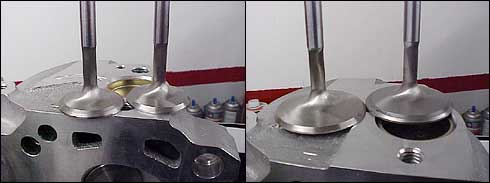
Now, let's get specific to Muscrate's cylinder
heads. The heads out of the box are actually
not too bad for a mild performance application
and if allowed by the rules could probably benefit
quite a bit from some pocket porting, bowl blend,
unshrouding of the valves in the combustion
chamber and a nice gasket match. Problem is,
that would be ILLEGAL! You see, the IHRA and
NHRA have some very specific rules and specifications
of what you can and (mostly) cannot do to heads
intended for Stock Eliminator duty. Basically,
NO porting, polishing, welding, epoxying, valve
unshrouding, or any other common form of head
modification is allowed.
Also, the stock size valves and stem diameter
must remain and no titanium or hollow stems
are allowed. The valve springs have to be the
same type (single for single, etc.) as what
would have come on the heads from the factory,
and must use a stock diameter retainer.

So, here is what you CAN do. In the photos
you can see a before and after of the intake
and exhaust valves. It is sometimes amazing
how well a head responds to a simple back-cut
of the valves. Also, I have found that most
exhaust valves respond well to gently radiusing
the leading edge of the margin where it transitions
from the face of the valve. The trick to all
this is countless hours of trying various angles
and widths of the back-cut and then FloBench
testing every modification. Even the amount
of radius on the exhaust valve effects flow.
| BEFORE |
| valve
lift |
0.100 |
0.200 |
0.300 |
0.400 |
0.500 |
0.600 |
average |
| intake |
56.70 |
115.70 |
165.80 |
194.30 |
212.20 |
221.00 |
152.28 |
| exhaust |
46.60 |
92.50 |
124.70 |
132.40 |
139.60 |
141.30 |
107.18 |
| AFTER |
| valve
lift |
0.100 |
0.200 |
0.300 |
0.400 |
0.500 |
0.600 |
average |
| intake |
63.70 |
125.50 |
172.80 |
196.80 |
210.50 |
217.60 |
156.24 |
| exhaust |
59.00 |
105.60 |
127.00 |
137.30 |
141.00 |
143.60 |
112.57 |
|
What's the pay-off for all this work? As the
flowchart shows, about 4 cfm average on the
intake and 5 cfm average exhaust. Seems hardly
worth the effort, I know, but those numbers
don't tell the whole story. If you look closely,
at .100" lift on the intake, the flow improved
7 cfm and at .200" lift we see a gain of 10
cfm. The exhaust faired even better at .100"
lift with a very nice gain of 12.4 cfm, and
at .200" another 13 cfm was gained. Not too
bad for JUST valve work.
Also, you will notice a loss of flow at .500"
lift on the intake of about 2 cfm and a 3 cfm
loss at .600" lift. It doesn't matter when the
maximum valve lift of my camshaft is limited
to .498" by IHRA for the 320hp/302.
So, what does all of this work end up getting
for a horsepower gain? Probably about 10 hp
at 7,000 rpm and an average of around eight
hp throughout the usable rpm range. Doesn't
sound like much to most people outside of the
"Stocker Wars," but considering all the rules
involved, I'll take that 10 hp any day.
In the next article, I will try not to be so
long-winded and get to the fun stuff. I just
wanted to give you readers of Drag Racing Online
a little closer look at the trials and tribulations
of what a "class racer" goes through in the
search for the edge you may need on the next
heads-up race that comes your way. You did know
that on occasion "Stockers" have a heads-up,
whoever-gets-there-first race, right? Why else
would we subject ourselves to this self-inflicted
abuse?
When in doubt, DO A WHEELIE!
|
Previous
Stories
|
 |
Project
4-Link
—
3/10/04
Building a 572ci Mopar Wedge
Motor for Project Top Dragster |
 |
"CAM-ROD-ERY"
Picking
The Right Low Buck Cam Combination
(PART2)
—
3/9/04 (PART1)
—
2/8/04 |
|
|
|